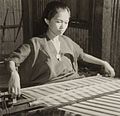Bodo blouse
 Girls wearing baju bodo or bodo blouse, worn with woven sarong. | |
| Type | Traditional blouse-dress |
|---|---|
| Material | Muslin, sheer cotton, silk |
| Place of origin | Indonesia (South Sulawesi)[1] |
The bodo blouse, locally known as Baju Bodo, is a sheer and transparent short sleeved loose blouse, a traditional costume for women of the Bugis and Makassar tribes of South Sulawesi, Indonesia.[1] A bodo blouse is traditionally combined with a matching woven sarong that covered the waist below the body.[2]
Costume components[]

Blouse[]
The textile materials used in bodo blouse are usually thin, sheer and transparent; usually muslin, sheer cotton or silk. Muslin is the most favoured materials, it has loose threads that make it look transparent and suitable for hot and humid tropical climate.
As the name implies, the term bodo in Bugis language means "short", which imply that this blouse is indeed short sleeved.[1] The cut of bodo blouse is quite simple, it follows the square design with holes or openings for neck, two arms and waist. Some design might has front opening, while others do not which resembles a loose tube. It also quite loose to allow the blouse to fit all sizes, and the design did emphasize the drape quality of the sheer fabrics.
Sarong[]
Bodo blouse is traditionally combined with a matching woven sarong that covered the waist. Commonly, Buginese people wore sarong wrapped around quite tightly. However, in this outfit the sarong is deliberately fitted loosely to match the loose draped shape of the bodo blouse top.[2]
Jewelries[]
This traditional clothes is considered incomplete if it is not complemented by jewelries or accessories. Some of these accessories includes earrings, headbands, tiaras, tiered necklaces, long necklaces, wide bracelets, multiple thin keroncong type bracelets and also metal belts. The accessories mentioned above are the complete variants which are commonly used by brides. Common guests usually uses fewer jewelries. These jewelries are usually made of gold or silver, while the simpler ones are made of brass instead.[2]
History[]

The sheer woven cotton as the materials of bodo blouse is believed has been made and used by people in Sulawesi since the 9th century.[2] In the past, bodo blouse were worn without undergarments, thus it exposed the breasts and curves of its wearer.[1] However, after the conversion of local Bugis and Makassar people to Islam in past centuries, the clothes that previously quite revealing was subdued to be more modest. This transparent outfit was then paired with undergarment of the same colour, but usually lighter in tone.
Usage[]
This traditional clothing is often worn for traditional events, such as wedding ceremonies. Although it has been increasingly marginalised due to the influence of modern clothing, or competing with other Indonesian national costumes such as kebaya and baju kurung, it remains prevalent in traditional Bugis villages. The bodo blouses are still worn by Bugis women, especially by brides during the marriage ceremony and wedding reception, as well as by the mother of the bride and groom, and the maid of honour.
Lately, the use of the bodo blouse has begun to expand for various activities, such as dancing and singing competitions or ceremonies for welcoming guests of honour. Today, bodo blouse has become a source of inspiration for contemporary Indonesian fashion designers,[3] and used as the inspiration of modern wedding dress.[4]
Colours[]
According to Bugis customs and traditions, specific colours of bodo blouse worn by Bugis women indicates the age and social standings of the wearer.[5]
| Colours | Meanings |
|---|---|
| Orange | Worn by female children aged 10 years old or younger. |
| Orange or red | Worn by girls aged between 10 to 16 years old. |
| Red | Worn by maidens aged between 17 to 25 years old. |
| White | Worn by dayang attendants, ritual dancers, brides, or female dukuns (witch doctors) |
| Green | Worn by noble women. |
| Purple | Worn by widows. |
Gallery[]

Pajoge dancers wearing bodo blouse, Maros circa 1870

A weaver wearing bodo blouse, circa 1945-1955

A girl wearing deep orange or red bodo blouse

Indonesian choir group wearing Bugis traditional costumes, the ladies wearing bodo blouse

Bugis girls wearing bodo blouse

A girl wearing bodo blouse with jewelries; headbands, earrings and necklace
See also[]
| Wikimedia Commons has media related to Baju bodo. |
- Kebaya
- Baju kurung
- National costume of Indonesia
References[]
- ^ Jump up to: a b c d Tim Indonesia Exploride. "Baju Bodo". IndonesiaKaya (in Indonesian). Retrieved 2021-02-18.
- ^ Jump up to: a b c d "Baju Bodo, Pakaian Adat Bugis yang Legendaris" (in Indonesian). 2021-02-03. Retrieved 2021-02-18.
- ^ Media, Kompas Cyber. "Baju Bodo dan Songket dengan "Modern Twist"". KOMPAS.com (in Indonesian). Retrieved 2021-02-18.
- ^ Media, Kompas Cyber. "Inspirasi Pakaian Bugis dalam Busana Pernikahan Indah Permatasari". kompas.com (in Indonesian). Retrieved 2021-02-18.
- ^ Gita (2009-06-21). "Mencari Perempuan Bugis". Kompasiana. Retrieved 2009-11-25.[permanent dead link]
- Indonesian clothing
- Bugis people
- South Sulawesi
- Makassar






